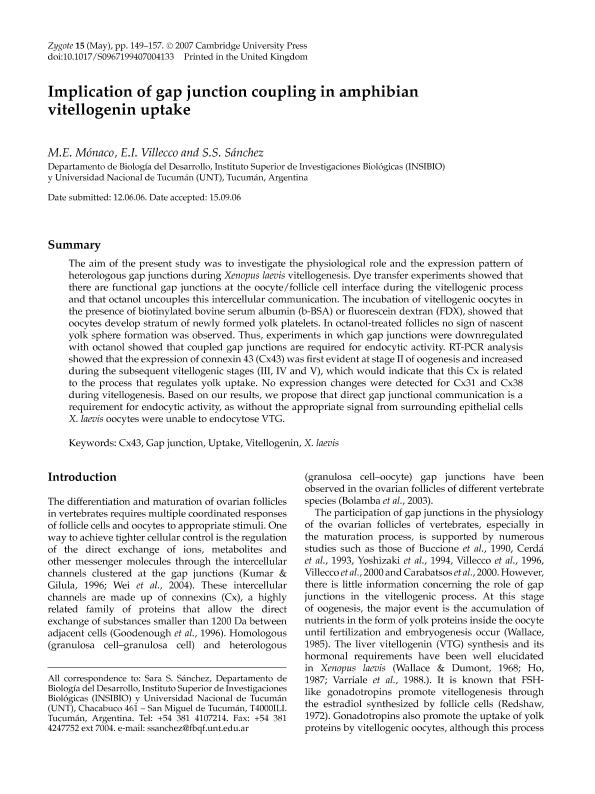Mostrar el registro sencillo del ítem
dc.contributor.author
Monaco, Maria Eugenia

dc.contributor.author
Villecco, E.I.
dc.contributor.author
Sanchez, Sara Serafina del V.

dc.date.available
2020-01-20T18:02:07Z
dc.date.issued
2007-05
dc.identifier.citation
Monaco, Maria Eugenia; Villecco, E.I.; Sanchez, Sara Serafina del V.; Implication of gap junction coupling in amphibian vitellogenin uptake; Cambridge University Press; Zygote; 15; 2; 5-2007; 149-157
dc.identifier.issn
0967-1994
dc.identifier.uri
http://hdl.handle.net/11336/95220
dc.description.abstract
The aim of the present study was to investigate the physiological role and the expression pattern of heterologous gap junctions during Xenopus laevis vitellogenesis. Dye transfer experiments showed that there are functional gap junctions at the oocyte/follicle cell interface during the vitellogenic process and that octanol uncouples this intercellular communication. The incubation of vitellogenic oocytes in the presence of biotinylated bovine serum albumin (b-BSA) or fluorescein dextran (FDX), showed that oocytes develop stratum of newly formed yolk platelets. In octanol-treated follicles no sign of nascent yolk sphere formation was observed. Thus, experiments in which gap junctions were downregulated with octanol showed that coupled gap junctions are required for endocytic activity. RT-PCR analysis showed that the expression of connexin 43 (Cx43) was first evident at stage II of oogenesis and increased during the subsequent vitellogenic stages (III, IV and V), which would indicate that this Cx is related to the process that regulates yolk uptake. No expression changes were detected for Cx31 and Cx38 during vitellogenesis. Based on our results, we propose that direct gap junctional communication is a requirement for endocytic activity, as without the appropriate signal from surrounding epithelial cells X. laevis oocytes were unable to endocytose VTG.
dc.format
application/pdf
dc.language.iso
eng
dc.publisher
Cambridge University Press

dc.rights
info:eu-repo/semantics/openAccess
dc.rights.uri
https://creativecommons.org/licenses/by-nc-sa/2.5/ar/
dc.subject
CX43
dc.subject
GAP JUNCTION
dc.subject
UPTAKE
dc.subject
VITELLOGENIN
dc.subject
X. LAEVIS
dc.subject.classification
Otras Ciencias Biológicas

dc.subject.classification
Ciencias Biológicas

dc.subject.classification
CIENCIAS NATURALES Y EXACTAS

dc.title
Implication of gap junction coupling in amphibian vitellogenin uptake
dc.type
info:eu-repo/semantics/article
dc.type
info:ar-repo/semantics/artículo
dc.type
info:eu-repo/semantics/publishedVersion
dc.date.updated
2019-05-27T17:07:40Z
dc.journal.volume
15
dc.journal.number
2
dc.journal.pagination
149-157
dc.journal.pais
Reino Unido

dc.journal.ciudad
Cambridge
dc.description.fil
Fil: Monaco, Maria Eugenia. Consejo Nacional de Investigaciones Científicas y Técnicas. Centro Científico Tecnológico Conicet - Tucumán. Instituto Superior de Investigaciones Biológicas. Universidad Nacional de Tucumán. Instituto Superior de Investigaciones Biológicas; Argentina
dc.description.fil
Fil: Villecco, E.I.. Consejo Nacional de Investigaciones Científicas y Técnicas. Centro Científico Tecnológico Conicet - Tucumán. Instituto Superior de Investigaciones Biológicas. Universidad Nacional de Tucumán. Instituto Superior de Investigaciones Biológicas; Argentina
dc.description.fil
Fil: Sanchez, Sara Serafina del V.. Consejo Nacional de Investigaciones Científicas y Técnicas. Centro Científico Tecnológico Conicet - Tucumán. Instituto Superior de Investigaciones Biológicas. Universidad Nacional de Tucumán. Instituto Superior de Investigaciones Biológicas; Argentina
dc.journal.title
Zygote

dc.relation.alternativeid
info:eu-repo/semantics/altIdentifier/doi/https://doi.org/10.1017/S0967199407004133
dc.relation.alternativeid
info:eu-repo/semantics/altIdentifier/url/https://www.cambridge.org/core/journals/zygote/article/implication-of-gap-junction-coupling-in-amphibian-vitellogenin-uptake/33AA6D4540DBD1BF8F9B4C045FA5E1CE
Archivos asociados
